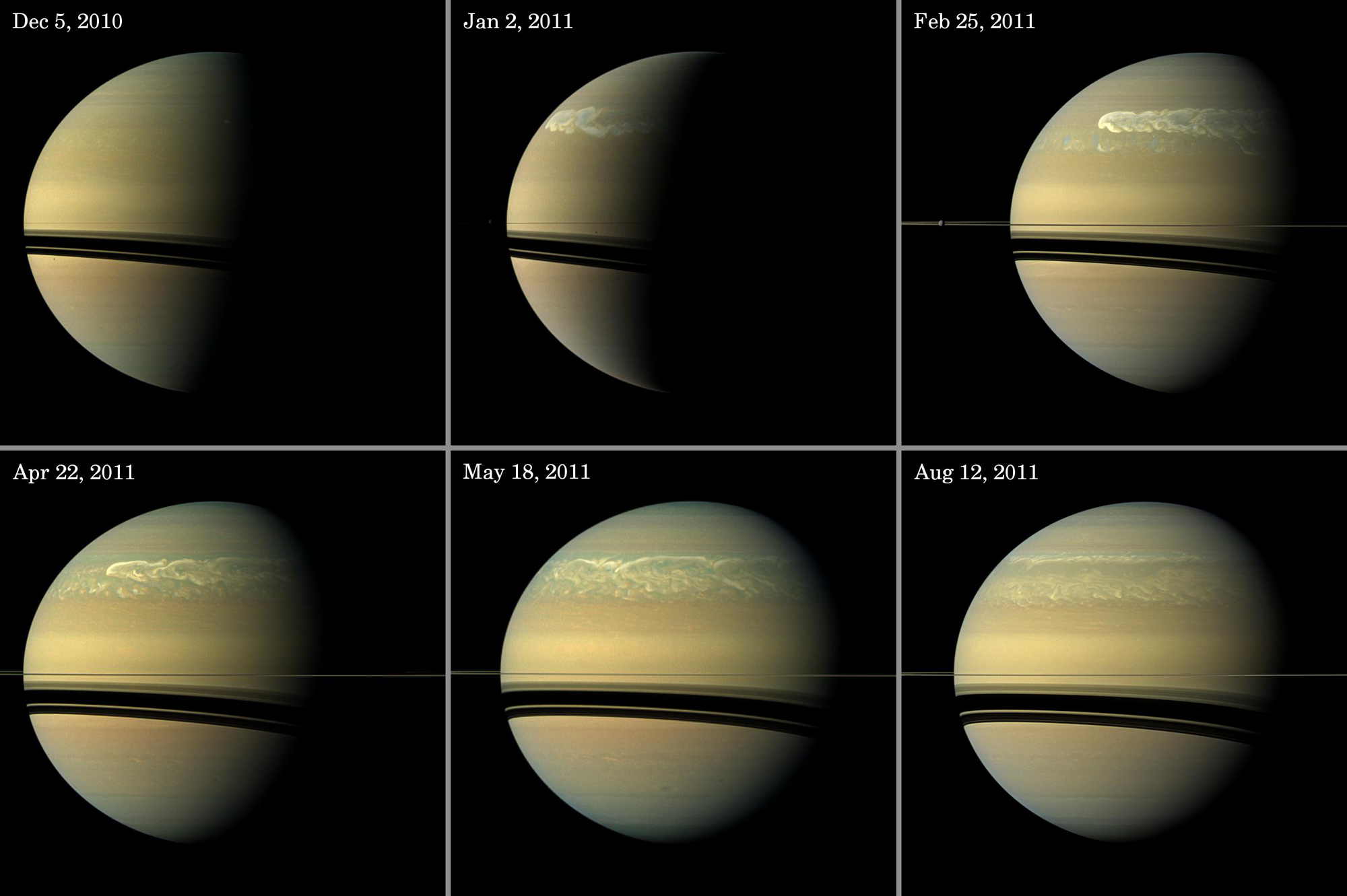Mystery of Saturn's Epic Planet-Encircling Storms Explained

Giant storms on Saturn known as "Great White Spots" may be caused by moisture in the planet's atmosphere, researchers say.
The titanic Saturn storms, which stretch across the planet, have erupted on the planet six times since they were first discovered in 1876. They resemble thunderstorms on Earth, except that each of these storms is about the size of Earth. The most recent storm began in 2010, which NASA's Cassini spacecraft arrived in time to watch, and grew long enough in six months to encircle the planet.
The Great White Spots that astronomers have seen in the past 140 years alternate between Saturn's equator and its mid-latitudes. They recur every 20 to 30 years, and it was a mystery why it took so long for these storms to ensue, said lead author of the new study Cheng Li, a planetary scientist at the California Institute of Technology in Pasadena. [See more photos of Saturn's colossal storms]
The new research suggests that water vapor in Saturn's atmosphere might be what suppresses these giant storms from developing for decades.
In general, storms are caused by the way hot and cold gases churn around in atmospheres, a process known as convection. On Saturn, water molecules are relatively heavy compared with the hydrogen and helium molecules that dominate the planet's atmosphere, so the water sinks down to form a separate layer. This wet layer does not mix with the other, dry areas, and this lack of convection suppresses giant storms for decades, the researchers say.
When moisture stifles convection in Saturn's atmosphere, warm air does not rise as it otherwise would. This eventually leads Saturn's upper atmosphere to cool and get more dense, eventually becoming heavy enough to sink. That circulation, in turn, causes warm, moist air to rise rapidly, and all this swirling eventually triggers a giant thunderstorm.
The research team found its model matches Cassini observations of the 2010 Great White Spot. The team's findings also explain another mystery: why so little ammonia vapor has been seen in the wake of these storms. The rising warm, moist air brings ammonia vapor along with it to the cold upper atmosphere, where it rains out, the researchers say.
Get the Space.com Newsletter
Breaking space news, the latest updates on rocket launches, skywatching events and more!
This work could help scientists estimate how much water Saturn has. "This is exciting, because water on Saturn is an imprint from the early solar system," Li told Space.com. "Its abundance will tell us about the formation history of Saturn."
The scientists also noted that the absence of planet-encircling storms on Jupiter might be due to the lower levels of water vapor in the larger planet's atmosphere compared to Saturn. Li noted that NASA's Juno spacecraft, set to arrive at Jupiter in 2016, will measure Jupiter's water levels, helping to test this idea.
Li and his colleague Andrew Ingersoll, also at the California Institute of Technology, detailed their findings online April 13 in the journal Nature Geoscience.
Follow us @Spacedotcom, Facebook and Google+. Original article on Space.com.
Join our Space Forums to keep talking space on the latest missions, night sky and more! And if you have a news tip, correction or comment, let us know at: community@space.com.

Charles Q. Choi is a contributing writer for Space.com and Live Science. He covers all things human origins and astronomy as well as physics, animals and general science topics. Charles has a Master of Arts degree from the University of Missouri-Columbia, School of Journalism and a Bachelor of Arts degree from the University of South Florida. Charles has visited every continent on Earth, drinking rancid yak butter tea in Lhasa, snorkeling with sea lions in the Galapagos and even climbing an iceberg in Antarctica. Visit him at http://www.sciwriter.us









